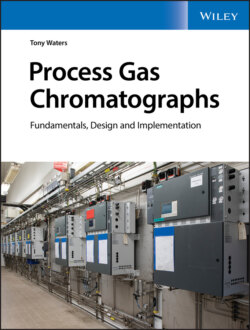Читать книгу Process Gas Chromatographs - Tony Waters - Страница 48
Effect of more equilibria
ОглавлениеFigure 2.9 is a graphic rendering of the equilibrium model that tracks the movement of the propane molecules relative to the movement of the carrier gas. The solubility of the molecules is again assumed to be 50 %. The carrier movement represents the distance moved by carrier gas molecules that were present at the instant of sample injection.
Each colored trace shows the distribution of molecules and the corresponding peak shape obtained for a different number of equilibria (N). In practice, the narrower peaks would be much higher: the scale of the vertical axis is not the same for each trace. When a column operates under optimum conditions, a peak experiences more equilibria as it passes through the same length of column, resulting in narrower peaks that are easier to separate.
Figure 2.9 Effect of Having More Equilibria.
The gold curve in Figure 2.9 is a smoothed version of the 1:4:6:4:1 distribution we obtained with five equilibria. This embryonic peak would appear in the first two millimeters of a regular packed column and would take less than one fourth of a second to form.
Continuing the jerky mechanism for more equilibria would be tedious, but luckily it can be done mathematically. Figure 2.9 also displays the curves for 50, 500, and 5,000 equilibria, plotted as if they occurred along the same length of column. They look just like chromatogram peaks! And that's exactly what they are. You have just witnessed how the standard peak shape forms.
In chromatography theory, the plate number (N) is the number of equilibria achieved by a column. Of course, the notion of separate equilibria occurring in the column is just a theoretical concept. One might argue that the gas and liquid never quite achieve equilibrium because the gas is constantly moving. True; and that leads to another theory of chromatography, which assumes equilibrium never happens. Nevertheless, even that theory ends up with a plate number to express the efficiency of a column, its ability to produce narrow peaks.
The plate number is a useful parameter for evaluating column performance. As is evident from Figure 2.9, anything that increases the plate number must be a good thing, because it reduces peak width and narrower peaks provide better separations.
